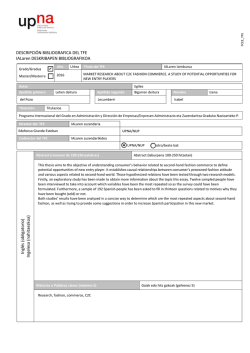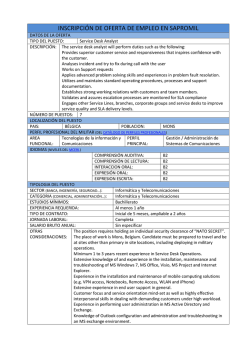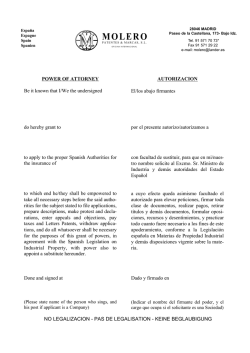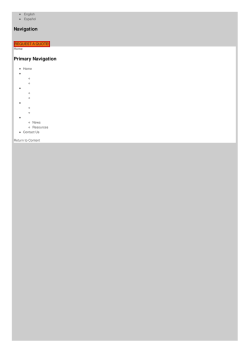
Developing Diagnostic Tools for National Monitoring and Evaluation
IDEAS Global Assembly 11 – 15 April 2011 Amman, Jordan Amman, Jordan Session 6.7 Complexity of Assessing Evaluation Approaches Developing Diagnostic Tools for National Monitoring g and Evaluation Systems: y A Pilot Experience in Latin America Idania Fernández, Jacques Lefevre, Nadia Croteau, Frederic Martin Pour un secteur public performant For public sector performance Por la excelencia del sector público © 2008 IDEA International Context in Latin America Also times of change and turbulence! Growth G h andd overallll emerging i economies: i B il Brazil, Chile, but also other countries such as Panama Latin America as a region g went through g the financial crisis relatively well At the same time, old issues of structural poverty andd inequality i li still ill there h andd even bigger bi b because benefits of growth were not shared among all social categories Faced with these persistent and even growing problems and pressure from citizens and civil society governments felt the need for new society, solutions © IDEA International 2011 © 2008 IDEA International Governments’ response to this situation in the region: New Integrated social protection programs Main poverty reduction strategy program: Conditional monetary transfers. Started in Mexico (Progreso in 1982 which became Oportunidades in 2000). 2000) Adopted later by: Brasil (Bolsa familia en el programa Fome zero en 2000) Chile (Chile Solidario en 2004) Honduras (Bono 10000, PRAF) El Salvador (Programa de Apoyo Temporal al Ingreso Familiar) Panamá P á (Red (R d de d Oportunidades O id d in i 2006) © IDEA International 2011 © 2008 IDEA International Challenges faced by goverments Very complex programs: o Many actors, many partnerships o Multiple activities to conduct, coordinate, and monitor o Issues of identification and follow up p of beneficiaries o Cost-effectiveness issue of delivery mechanism o Need to demonstrate outcomes and impacts o Subject to external and internal shocks Need for a solid results-based M&E y system! © IDEA International 2011 © 2008 IDEA International Challenges for setting up and implementing a results-based M&E system SStarting i or young M&E M E systems: o No baseline; systems only designed, but not fully implemented o Weak logical g frameworks linkingg outputs p to outcomes to impacts, p o Data quality issues o Limited use of results o Limited human capacities o Limited culture of results o Multiple, ad hoc, and donor driven M&E systems for some time; now i improving i with i h move towards d a national i l M&E system In spite of all those challenges, M&E systems were put in place. Now the challenge is: to know where are we in terms of national M&E systems; and how p them? to improve © IDEA International 2011 © 2008 IDEA International National M&E system diagnostic tool Project of SISCA with support from World Bank Concept paper by Ray Rist Objectives of the tool: Guide a structured and participatory diagnostic of the National M&E system Guide the formulation of a priority action plan to improve the performance of the system y Herramienta de Diagnóstico del Sistema de Monitoreo y Evaluación de Programa de Protección Social (MESOC) Dimensión del diagnostico D1 Version 1 04 d de ffebrero b d de 2011 Estructura del MESOC Definición D2 Pre-condiciones para un sistema de M&E basado en resultados Mecanismos institucionales de M&E del p programa g D3 Planificación y presupuesto del M&E del programa D4 Desempeño real del componente de monitoreo del programa Desempeño real del componente de evaluación del programa D5 Repeat this exercise every 2-3 years for a stepwise improvement in the M&E system (example of PEFA approach in public finance) © IDEA International 2011 © 2008 IDEA International Diagnostic tool structure - Part I: Diagnostic of the OVC National M&E system Key dimensions: o RBM prerequisites o Legal and institutional frame plan and budget g o M&E p o Monitoring implementation o Evaluation implementation Key questions: existence, quality, and use Quantitative assessment on an ordinal scale and qualitative evaluation to justify the quantitative assessment © IDEA International 2011 © 2008 IDEA International Diagnostic tool structure - Part II: Action Plan to improve the OVC national M&E system Identification of existing relevant actions Identification of additional actions Prioritization of actions Characterization of actions (Tasks, Roles and responsibilities, Ti Timetable, bl Budget B d andd funding f di needs) © IDEA International 2011 © 2008 IDEA International Overall Process 1. Documentation review (international, national) 2. M&E group work sessions 3. Individual stakeholder sessions 4 Field visit 4. isit 5. Workshop(s) for diagnostic and formulation of elements of an action plan 6. Analysis and report writing on diagnostic g and action p plan 7. Discussion and validation of diagnostic and action plan with stakeholders 8. Action plan implementation © IDEA International 2011 © 2008 IDEA International Issues based on experience so far Generic vs. tailor-made Optimal p degree g of disaggregation gg g (number of indicators) Choice of scales Identification and involvement of stakeholders (national/local) Ownership of the tool and of the process Indicators on risk in turbulent times © IDEA International 2011 © 2008 IDEA International Conclusion This tool is not an end in itself; it facilitates a systematic, stepwise, evidence-based process off improvement of the national M&E system. system Pilot test in El Salvador, Honduras, and Panama. © IDEA International 2011 © 2008 IDEA International Thank You! © IDEA International 2011 © 2008 IDEA International
© Copyright 2025



